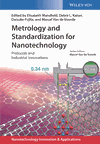Stochastic Aspects of Sizing Nanoparticles
Abstract
Nanoparticles are three-dimensional objects and their size is best described by volume, V, which can be measured directly from their three-dimensional images. The geometry of individual nanoparticles is frequently investigated using two-dimensional images consisting of particle sections or projections. Stereological methods should be used to infer volume distribution from the measurements carried out on such sections/projections as the two-dimensional images depend on both size and shape of particles. Experimental size distribution functions can be obtained from measurements of size of individual particles by random sampling from the population of interest. In this context, it should be noted that measurements carried out on microscopic images require special procedures to assure that the probability of sampling does not depend on the size of a given particles.



